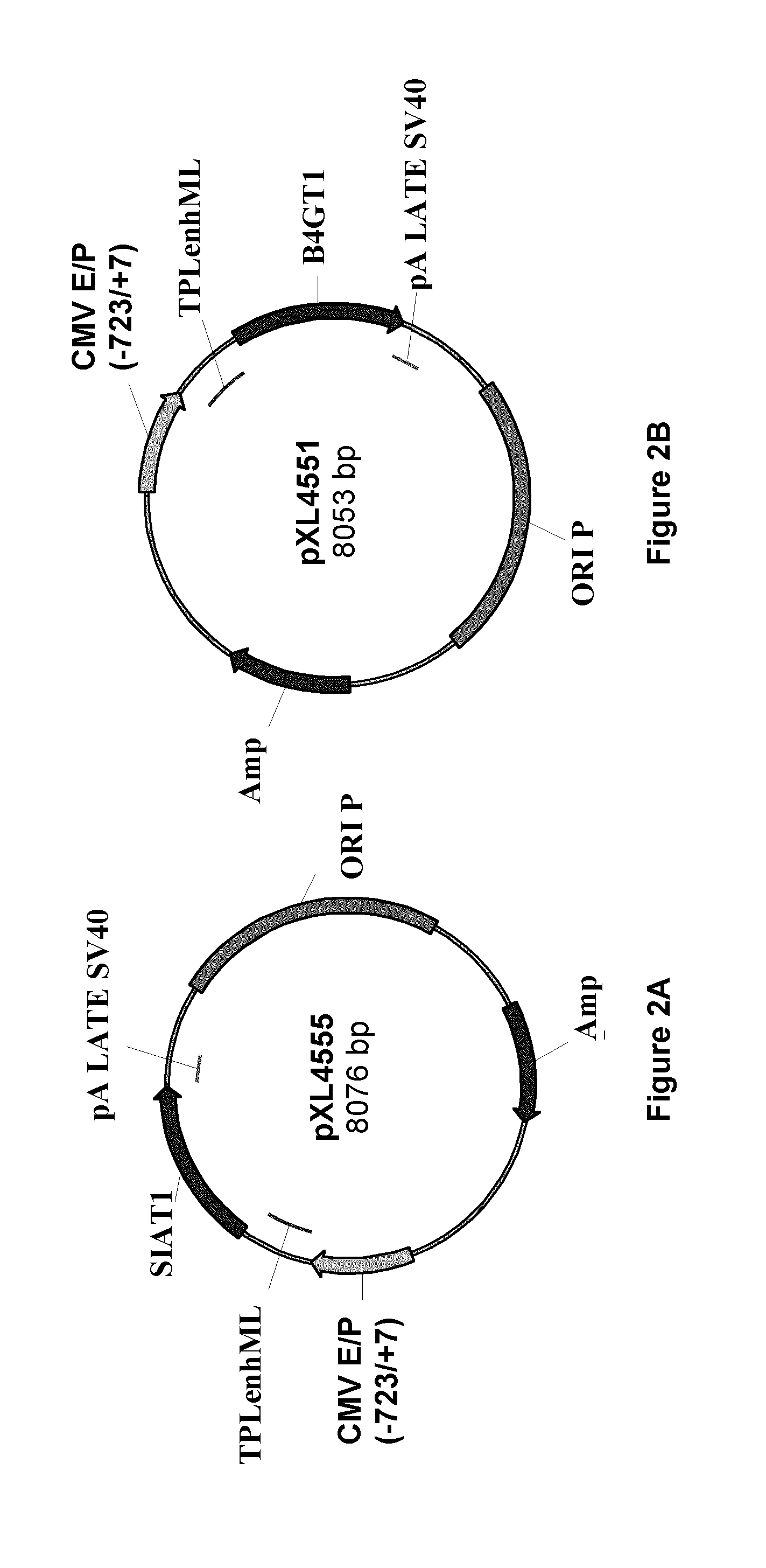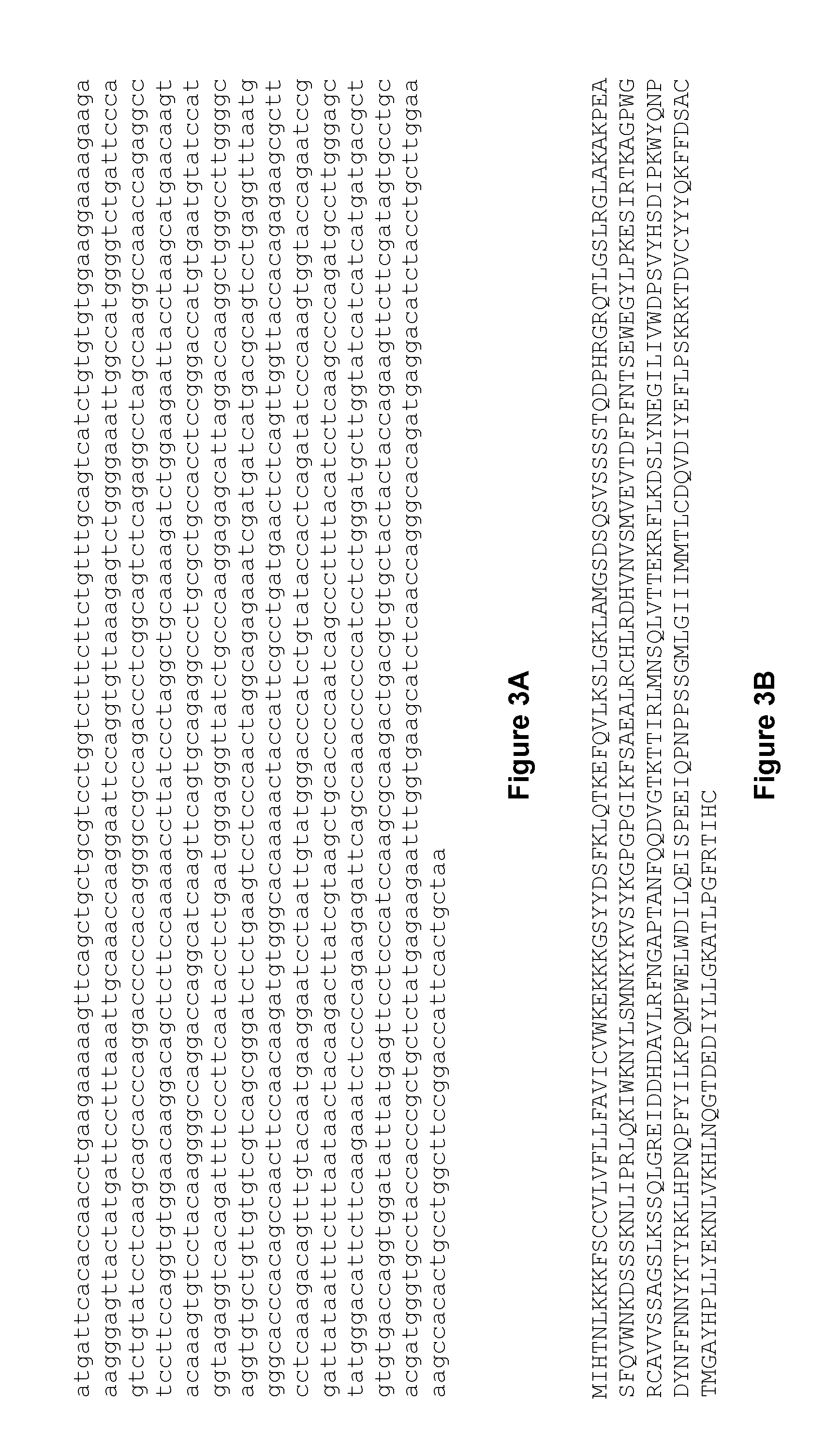Method of production of sialylated antibodies
a technology of sialylated antibodies and sialylated antibodies, which is applied in the field of production of sialylated antibodies, can solve the problems that the prior art does not allow the production of extensive sialylated antibodies in amounts, and achieve the effect of proportionally reducing or increasing the dos
- Summary
- Abstract
- Description
- Claims
- Application Information
AI Technical Summary
Benefits of technology
Problems solved by technology
Method used
Image
Examples
example 1
Low mAb Productivity when Glycosyltransferases are Overexpressed
[0147]In this example, the transient production of a monoclonal antibody (mAb) in the presence of glycosyltransferases was shown to decrease significantly while the concentration of plasmids encoding these glycosyltransferases increased.
[0148]The cDNAs encoding human α-2,6 sialyltransferase (SIAT1) (SEQ ID No. 33) or human β-1,4 galactosyltransferase (B4GT1) (SEQ ID No. 35) were retrieved from a clone collection (Invitrogen) and inserted into the mammalian expression vector pXL4214 from which expression is driven from the CMV promoter to generate plasmids pXL4555 and pXL4551. Maps of plasmid are presented on FIG. 2, the nucleic acid and corresponding amino acid sequences of SIAT1 and B4GT1 are on FIGS. 3 and 4 respectively. The same expression vector was also used to clone the cDNA encoding the light chain (LC) and heavy chain (HC) of the murine AntiAbeta—13C3 mAb. Plasmid pXL4808 encoded LC of antiAbeta—13C13 mAb, FIG....
example 2
Production of mAb Variants with α-2,6-Sialylated N-Glycan in Fc
[0152]In this example, the production of mAb variants with α-2,6-sialylated N-glycan in Fc is described by transient expression in mammalian cells HEK 293 or CHO at small scale. The same expression vector was used to clone the cDNA encoding LC and HC of AntiAbeta—13C3 mAb variants. The following plasmids were generated and were shown on FIG. 5. Plasmid pXL4808 encoded LC of antiAbeta—13C13 mAb, FIG. 5A; Plasmid pXL4792 encoded HC of antiAbeta—13C13 mAb, FIG. 5B; Plasmid pXL5105 encoded the modified HC of AntiAbeta—13C3_D257A, FIG. 5C; Plasmid pXL5111 encoded the modified HC of AntiAbeta—13C3_F235A mAb, FIG. 5D and plasmid pXL5132 encoded the modified HC of AntiAbeta—13C3_V256A mAb, FIG. 5E. The nucleic acid and corresponding amino acid sequences of the LC and HC mAb variants were described on FIGS. 6, 7, 8, 9 and 10. The nucleotide sequences of the HC AntiAbeta—13C3_F235A, AntiAbeta—13C3_V256A, and AntiAbeta—13C3_D257A m...
example 3
Large Scale Production of mAb Variant with α-2,6-Sialylated N-Glycan in Fc
[0158]In this example, the production of antiAbeta—13C3_D257A mAb with α-2,6-sialylated N-glycan in Fc is described by transient co-expression with SIAT1 and B4GT1 in mammalian cells at large scale. Characterization and binding specificities of this mAb were compared to the same antiAbeta—13C3_D257A mAb produced without co-expression of SIAT1 and B4GT1.
[0159]AntiAbeta—13C3_D257A mAb variant was produced in suspension-cultivated 293-F cells in 10-L Wave Bioreactor by transient co-expression of the four plasmids encoding the HC (pXL5105), LC (pXL4808), SIAT1 (pXL4555) and B4GT1 (pXL4551) complexed with 293Fectin™, using the optimal plasmid ratio used in Example 1. The batch was harvested 8 days post transfection and named LP10104. Another batch named LP10116 was also produced in suspension-cultivated 293-F cells in 10-L Wave Bioreactor by transient co-expression of the plasmids encoding the HC (pXL5105) and the ...
PUM
| Property | Measurement | Unit |
|---|---|---|
| Fraction | aaaaa | aaaaa |
| Composition | aaaaa | aaaaa |
| Cell angle | aaaaa | aaaaa |
Abstract
Description
Claims
Application Information
 Login to View More
Login to View More - R&D Engineer
- R&D Manager
- IP Professional
- Industry Leading Data Capabilities
- Powerful AI technology
- Patent DNA Extraction
Browse by: Latest US Patents, China's latest patents, Technical Efficacy Thesaurus, Application Domain, Technology Topic, Popular Technical Reports.
© 2024 PatSnap. All rights reserved.Legal|Privacy policy|Modern Slavery Act Transparency Statement|Sitemap|About US| Contact US: help@patsnap.com










